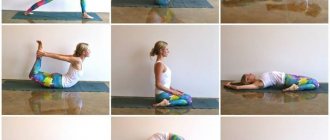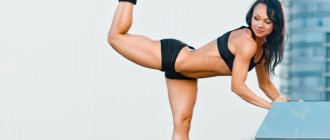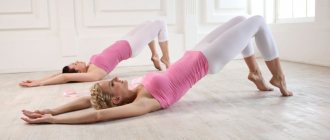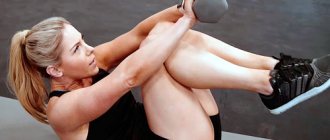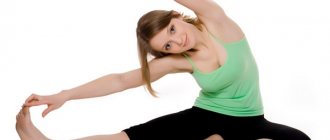Where to start practicing hatha yoga: basic tips and complexes
SPORT AND FITNESS
Yoga for flexibility
Yoga has a variety of effects on human health. N...
HEALTH
Yoga for beginners: an exercise that will help you relax before bed
Can't fall asleep quickly due to an endless stream of thoughts? M...
HEALTH
What is the difference between yoga, Pilates and stretching and what to choose for yourself
Let's figure out the similarities and differences between yoga, Pilates and stretching.
SPORT AND FITNESS
8 simple asanas for beginners in yoga
Downward-facing dog pose, tree pose, warrior pose and others are not...
SPORT AND FITNESS
4 exercises to help get rid of lower back pain
Back pain and getting rid of this problem is a topic, unfortunately...
SPORT AND FITNESS
Best Resources for Free Yoga Lessons
What to do on Sunday? You can do a lot of things, but you can also do yoga...
SPORT AND FITNESS
8 Yoga Apps
Your little helpers in achieving mental balance and physical perfection.
HEALTH
10 best asanas for daily practice and all levels of training
Just 10-15 minutes a day spent exercising will help you get into good physical shape.
iOS
Recommendations for performing the complex
- For the first time
, and if necessary, then the second time, analyze in detail all the exercises of the yoga complex for beginners at home. Your task is to understand and feel the correct functioning of all parts of the body in the asanas of the lesson. - When the correct execution is mastered
, start practicing according to time (for example, use a stopwatch on your phone). Stay in asanas for stretching and increasing flexibility for the entire time indicated in the lesson. Stay in power asanas for as long as possible, plus another 3-5 seconds. Then rest. If time permits, enter the asana again. For one-sided asanas, the printout of the complex indicates the total time (for performing on both sides), take this into account. - At first, if it’s really hard for you
, your breathing becomes too quick and does not have time to recover during “calm” asanas, stop the stopwatch and give yourself additional rest, lie down in shavasana for 3-5 minutes and recover. Be attentive to yourself and your well-being. Yoga does not require you to force yourself. - Periodically return to the description of the technique
of performing asanas. Most likely, you will discover something new that was not entirely clear after the first reading, or something that you missed. - During menstruation,
it is not recommended to perform asanas marked with the “M!” icon. During this period, it is advisable to especially listen to your feelings and perform yoga practice either very gently or completely stop it (especially in the first two days of the cycle).
Stretching yoga for beginners (performed at home)
This set of exercises perfectly stretches the spine, making the body feel light. At the same time, your neck and back will be healthy! For classes you will need only 5 minutes of free time.
Place your feet shoulder-width apart, bend forward and clasp your hands as shown in the photo. Stay in this position for a few seconds.
Place your hands behind your back and lock them together, bend forward and reach up with your hands.
Take a slide pose and alternately bend one leg and then the other. Do the exercise 10 times.
From the slide position, move your body forward and bend your back.
Then slowly return to the starting position. Repeat several times.
Take the pose as in the photo and stretch up and back.
Switch sides and do the same exercise.
Again, place your feet shoulder-width apart, bend with your hands together, and stand as long as you like. At this point, the stretching workout can be considered complete.
And you, my dears, practice yoga. Do you like these exercises? Write in the comments about your impressions and results. Happy training! If you found the article useful, share it on social networks. See you again on the blog!
Yoga for beginners - a simple set of exercises for children
This exercise helps children get to know their bodies and improve their health. As practice shows, not only physical health (including immunity) improves, but also psycho-emotional health. Do this kind of gymnastics with your kids every day, and positive results will please you in just a couple of weeks!
In a sitting position, as in the photo, take a deep breath and spread your arms to the sides. As you exhale, hug yourself tightly. Repeat the exercise 3-5 times.
Stretch your arms forward and move your fingers as if you have claws instead of them.
Scissors by hand. Repeat the exercise 10 times.
Stretch your arms to the sides, clasp your palms into fists and make rotational movements, first in one direction, then in the other. Repeat 10 times in each direction.
Raise your arms up and stretch as high as possible. Stay in this position for a few seconds.
Stretch your legs forward and alternately bend one or the other foot. Do the exercise for one minute.
Leg scissors. Repeat 10 times.
Sit as shown in the photo and vigorously swing your legs for one minute.
Squat, spread your legs to the sides, keep your hands in a prayer position at chest level. Jump in this position several times like a frog.
Now get into turtle pose by placing your hands behind your legs and pulling your head up, feeling the muscles stretch. Stay in this position for a few seconds.
Stretch your legs forward, tilt your body towards your legs, grab your toes with your hands and stretch.
Get on all fours. Alternately smoothly extend your right arm and left leg, then your left arm and right leg. Repeat 5-7 times for each position.
Take a table pose as shown in the photo. Slowly raise and lower your body.
Make the previous exercise a little more difficult. Alternately lift one or the other leg 3-5 times.
Stand up, stretch your arms in front of you and begin to alternately raise your knees high to touch your hands. We walk like this for one minute.
Raise your arms up, stretch, then smoothly bend first to the right, then to the left. Complete your workout.
Where to start practicing at home
Home workouts require more self-discipline and motivation than gym or group classes. Before you start practicing yoga at home, it is advisable to get at least a few lessons from an experienced trainer, if possible. The master will help you choose the optimal training regimen, loads, and tell you how to exercise correctly. After such training, your home yoga will become a logical continuation of the path of improving body and spirit.
- Symptoms of gonorrhea in women
- How to block a Beeline SIM card yourself via the Internet or from another phone
- Fasting day on kefir - benefits and harm. Reviews about the results of a fasting day on kefir
To prevent training from the very beginning from turning into an unbearable ordeal for you, you should follow several important principles of independent home exercises:
- When choosing a set of exercises on the Internet, rely on the teacher’s experience, his figure and even the quality of the video materials that he offers in the form of a training manual. If a book is chosen as a manual, then it should contain photos and pictures with a detailed description of the execution sequence.
- Never do any exercise without first warming up your muscles, tendons and joints.
- Start with those exercises that do not cause you discomfort or discomfort. Each body has its own individual characteristics and level of stretching.
- Learn to listen to your body, muscles, your own pain. Direct all sensations to explore these feelings. You must learn to hear the signals coming from the body.
- Constantly control your breathing - this is the basis of yoga. At first it will seem impossible, but over time the skill will come. Every inhalation and exhalation should be done consciously. Breathing control is a very good distraction from the unpleasant sensations that sometimes arise during exercise.
Joy Yoga: Yoga for Beginners with Joy Nielen-Groen
Joe Neelen-Groen has been practicing yoga for a long time and offers his own version of the program. In general, it is based on the classical elements of yoga, but is very gentle and soft. Joy yoga is not only suitable for beginners, it can be shown to people with certain physical ailments, as everything in it is performed very slowly and smoothly. Safety is one of Joy's main requirements for practice. But, of course, if you have illnesses or injuries, you should consult your doctor before exercising.
You won't find any difficult asanas here. This will be a large warm-up complex, child's pose (Balasana), standing bend (Uttanasana), bending in Tadasana, standing obtuse angle (Prasarita Padottanasana), some variations of mountain pose and other very easy poses.
The complex is quite relaxing, so it is suitable for performing in the evening.
Video: Jo Yoga for Beginners with Jo Neelen-Groen
Tips and rules for organizing home yoga classes
- When practicing yoga at home, be sure to make sure that the room is warm and free of drafts, since you should not freeze while practicing yoga. This is due to the fact that in a cold room it is more difficult for muscles and ligaments to warm up, which leads to incorrect and less effective exercises, as well as the risk of spraining ligaments and muscles.
- To conduct a yoga complex at home, take care of complete silence and tranquility; nothing should distract or irritate you. If you are blinded by bright light, you can put a blindfold on your eyes; if there is still extraneous noise, you can insert earplugs into your ears.
- When performing asanas, especially if you are doing it for the first time, do not try to bring the poses to perfection through pain; at the initial stage they can be performed with incomplete amplitude. This will reduce the risk of injury, and will also gradually prepare the ligaments, joints and muscles for the final position. The main thing in yoga is perseverance and patience; mistakes will be corrected as you master the technique.
- Start the exercise only in the absence of physical or psychological stress; you should feel cheerful and in a relaxed state. If you are depressed or worried about something, do savasana, the so-called corpse pose. In which you need to achieve maximum relaxation and drive away all disturbing thoughts. By the way, you can end a yoga class with an asana like shavasana.
- Of course, in the initial stages of home yoga, you need to learn how to perform asanas correctly, but do not forget about relaxation and even and continuous breathing.
- In the intervals between asanas, relax those muscles as much as possible, since when performing a certain asana, muscle contraction occurs, which should subsequently be replaced by relaxation, for example in shavasana. A minute's rest will be enough during which you relax your muscles and perform several calm breathing cycles, which will also restore your heartbeat.
- Try to perform asanas at a slow pace, balancing and maintaining balance, movements should be as smooth as possible. However, make sure that the body remains stable and does not sway from side to side.
- Be sure to start your home yoga class with the mindset that you will succeed. Choose a few simple asanas that you can master with ease and practice them each time, honing your technique. With each new workout, try to perform the asanas more deeply and stay in this position a little longer than the last time, this way you can develop your body more effectively.
- Each asana should be performed at a slow pace, going through three stages: entering the asana, staying in a fixed position, and returning to the starting position. Do not try to quickly enter the final position of the asana; slowly and gradually first master its intermediate positions.
- While you are doing yoga training at home, try to avoid rushing and if you have already started the lesson at a measured, rather slow pace, then bring the workout to the end without trying to finish it quickly. If, nevertheless, time does not wait, in this case, reduce the training not by increasing the speed of the exercises, but by reducing their number. You can also reduce the number of repetitions of each asana, but you should not reduce the time spent in one or another asana.
- When conducting yoga training at home, try to concentrate your attention on what you are doing, and not fly with your thoughts in the clouds; when performing each stage of the asana, your attention should be concentrated on movement and correct, calm breathing.
- Only after you have completely mastered the initial, non-complex asanas and your body has acquired sufficient flexibility, can you move on to more complex asanas, which should also be mastered gradually. You can hold difficult asanas in the first stages for a few seconds, increasing the time spent in it with each training session. However, when you begin to master complex yoga exercises, you should not forget about the initial asanas that you have already mastered; for you at this stage they are the most effective, while you are just beginning to master complex poses.
- When you have reached the final position of the exercise, hold it for as long as possible, while remaining motionless. If you have performed the asanas correctly and are relaxed in both your thoughts and body, then after completing the practice you should feel good and light. If, while in a pose, you feel anxiety or discomfort, then leave the asana without delay.
- After you have lingered in the final position of the asana, begin to slowly exit the pose, just as when entering the asana, return to the starting position at a very slow pace.
- Repeat each asana 4-6 times; if you are already able to follow the technique of performing and holding the asana, the number of repetitions can be reduced.
- However, performing asanas is not the last thing you should learn; one of the main points in yoga is mastering the correct breathing technique (pranayama) and mastering meditation, which should end each yoga session. Read about this in our next articles.
- It is better to do yoga on an empty stomach, therefore, for home yoga, early in the morning immediately after waking up is suitable, this will also allow you to practice with a fresh mind without having heavy thoughts and experiences that can accumulate during the day. If you nevertheless decide to practice during the day or in the evening, then you should conduct a home yoga workout no earlier than 2-4 hours after eating. Before practicing yoga, you should drink some water, green tea or natural juice, and you can also allow yourself a couple of sips of warm milk. Between performing asanas, you can also drink a couple of sips of water.
- After classes, you should not engage in vigorous activities; you should also take a shower before, and not after, yoga classes. This is due to the fact that during yoga exercises, long-term changes in blood circulation occur in the body, which should gradually return to normal functioning.
Yoga for beginners with Tatyana Borodaenko
A series of videos with Tatyana Borodaenko consists of 20 lessons that are performed according to the Iyengar yoga system. The essence of this teaching is that safety and painstaking adjustment of each asana come first. It is necessary to get into the desired body position as accurately as possible, which may not be very easy for a beginner practitioner. In this regard, various auxiliary means are used: bars and bricks, belts, rollers or blankets. All this, if necessary, is placed under the head, back, buttocks in order to obtain the correct position, but also to make the asana comfortable and eliminate the possibility of injury.
We invite you to watch the first three lessons in the series.
Video: Yoga for beginners. Tatiana Borodaenko. 01
In the first video you are offered a complex of the simplest basic asanas, such as:
- mountain pose (Tadasana),
- tree pose (Vrikshasana),
- extended triangle pose (Utthita Trikonasana),
- wind pose (Ekapada Pavana Muktasana)
- Dead Man's Pose (Shavasana).
That is, this course is designed for absolutely “zero” practitioners, and it can be completed even without any preparation.
Video: Yoga for beginners. Tatiana Borodaenko. 02
In this lesson, hero pose II (Virabhadrasana II), leg extension pose (Urdhva Prasarita Padasana), forward bend (Atha Mukha Virasana) will be added to Tadasana, Utthita Trikonasana.
Video: Yoga for beginners. Tatiana Borodaenko. 03
In this lesson you can learn several more simple asanas: lightning pose (Vajrasana), bridge pose (Setu Bandha Sarvangasana), bending in Sukhasana. However, please note that, for example, bridge pose can be difficult for people with a stiff or diseased spine or neck problems. In this video, you can still repeat this pose, since it is performed with auxiliary devices in a very easy version.
This is the whole peculiarity of this complex; it is suitable for older people, for people with injuries and various problems of the neck, back, joints, and poor flexibility. However, if you have any health concerns, be sure to consult your doctor first.
To begin with, you can try several complexes and choose the teacher you like. In the future, you will be able to independently navigate what you need to do and how, what direction to choose and what type of yoga to follow.
Yoga for weight loss at home - exercises for beginners
This complex is recommended to be performed in the morning. Then exercises will help you not only tighten your body, but also recharge your batteries.
Place your feet shoulder-width apart, raise your arms up and clasp them together. As you inhale, slowly stretch up, then bend to each side, forward and back. Hold each position for a few seconds, feeling how pleasantly your muscles stretch.
Now clasp your hands behind your back and stretch, slowly lean forward several times, breathing evenly.
Feet shoulder-width apart, right leg slightly bent at the knee. Lean forward, touching your left leg with your right hand, and reach up with your left hand. Hold this position for a few seconds. Do a similar exercise for the other leg.
Stand upside down. Breathe evenly, hold and stretch in this pose.
Lie on your stomach with your palms on the floor. Raise your body as much as possible with your head thrown back, stretch for a few seconds.
Now clasp your legs with your hands and sway in this position like a boat.
Lie down as shown in the photo. Stretch pleasantly for a few seconds.
Get on all fours and smoothly arch and arch your back like a cat. Repeat the exercise 3-5 times.
Take a “slide” pose, and then smoothly squat several times.
Place your weight on your right leg and extend your left leg back. Turn your body to the right as much as possible and hold in this position. Do the same in the other direction.
Take a pose as in the photo. Stretch up and back as much as possible. Do the exercise with each leg.
Place your feet shoulder-width apart, bend forward and clasp your hands as shown in the photo. Stay in this position for a few seconds. Then stand up straight and shake your arms and legs. Complete your workout.
